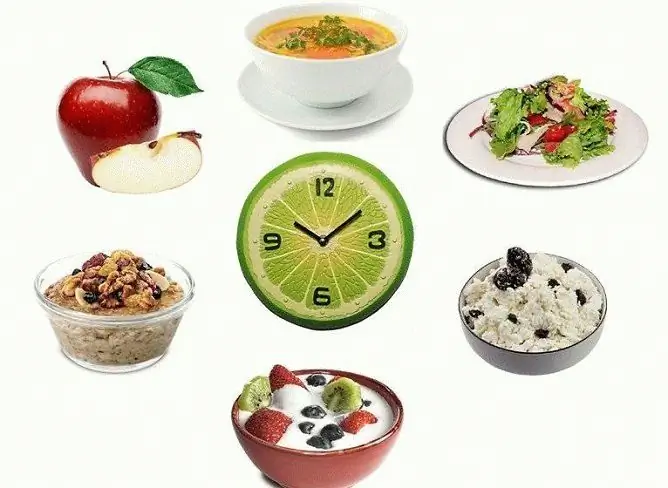- Author Rachel Wainwright [email protected].
- Public 2023-12-15 07:39.
- Last modified 2025-11-02 20:14.
How to eat right for women of different ages?
Proper nutrition is a constant condition of health and well-being for many years. But at each stage of life, the diet has its own characteristics that must be taken into account in order to support the body with those substances that are most necessary for it at the moment. By eating optimally, a woman can feel energetic and strong, adapt to changes in the body and remain active at any age.
For those over 20
In pursuit of success and attention of the opposite sex, young girls rarely care about their diet, but in vain. It is at this age that the foundations of a woman's health are laid and either the basis for a prosperous old age is formed, or the prerequisites for future diseases.
20-year-old girls often limit their diet by following strict diets. However, it is at a young age that this is not recommended. With a moderate intake of food, a fast metabolism will not allow you to gain excess weight, but depriving the body of proteins will do it badly: due to a decrease in muscle mass, a girl can become very stout after 30 years. It is recommended to maintain shape during this period through physical activity or one fasting day per week (apple, cucumber, kefir).
Nutritionists recommend that girls eat fiber-rich foods, as a lack of dietary fiber at a young age can trigger high blood pressure and gastrointestinal problems in adulthood. In addition, the period from 20 to 30 years is a time to take care of the musculoskeletal system: a sufficient amount of calcium during these years will ensure good bone density, which will reduce the risk of osteoporosis in the future. Therefore, the girl's diet should be enriched with dairy products (kefir, yogurt, cheese), proteins (fish, cottage cheese, boiled meat), as well as whole grain cereals and vegetables.

Source: depositphotos.com
For those over 30
Age after 30 years is full of all sorts of stresses: this is taking care of children, and the need to build a career. It is necessary to closely monitor food habits, not allowing yourself to "seize" problems or excessively consume flour and sweets. The metabolism of a 30-year-old woman has already been slowed down, and everything that was eaten too much will definitely be deposited on the waist, abdomen and hips. This age is dangerous because the weight gained due to excesses is difficult to lose, and after 40 years, obesity will call into question the health of the joints and blood vessels.
Therefore, an important rule in the nutrition of women after 30 years is to observe moderation. It is better to limit the consumption of potatoes, pasta, sweets, replacing them with protein products. However, a woman's diet should still be rich in fruits, vegetables and fermented milk products.
The period from 30 to 40 years is the last chance to start eating healthy. This is the time when healthy food will still allow you to protect the body from serious ailments arising from the presence of harmful foods in the diet. Further, it will be more difficult to fight diseases by adjusting your eating habits.

Source: depositphotos.com
For those over 40
After 40 years, the function of the ovaries begins to fade. Along with a decrease in the production of female hormones (estrogens), adipose tissue begins to take on their role, for which, during menopause, the body provokes the growth of fat cells by increased stimulation of appetite. Despite the natural weight gain at this age, it is impossible to follow a diet after 40 years - the complete absence of subcutaneous fat against the background of menopause will lead to a sharp deterioration in the condition of the skin, insomnia, malfunctioning of blood vessels and the heart. Therefore, all fast carbohydrates are excluded from the diet of a mature woman. It is necessary to give preference to products that replace estrogens with their plant analogues - phytoestrogens. Such products include soybeans, legumes (beans, peas, chickpeas, lentils), dairy products, vegetables and herbs (carrots, cabbage, garlic, celery, parsley), vegetable oils (sunflower,olive, sesame, linseed), as well as rice, barley, oats, sunflower seeds.
In addition, after the age of 40, you can engage in intensive prevention of Alzheimer's and cancer. To prevent diseases, you should include sources of antioxidants in your diet: bright vegetables and fruits.

Source: depositphotos.com
For those over 50
It is these years that clearly show the success (or failure) of a woman's eating habits - did they create the basis for healthy aging or did they only aggravate its signs? At this time, diseases associated with errors in nutrition begin to appear: diabetes mellitus, vascular atherosclerosis, hypertension. Then the best solution would be a low fat diet rich in vegetables and fruits. Also, all 50-year-old women should think again about calcium intake and increase the proportion of dairy products and products containing omega-3 fatty acids in their diet.
50 years is not a reason to give up moderate physical activity, burning excess weight, which is fraught with joint diseases, shortness of breath. An active lifestyle and feasible sports are especially necessary at this time.

Source: depositphotos.com
Meals after 60
At this age, the ability to assimilate vitamins and minerals (namely, calcium, iron, folic acid, vitamins B6 and B12) with food decreases. Consequently, the need for them is increasing. Older women are encouraged to remember to include lean meats, eggs, fish, grains, and dairy products in their menu (bones begin to lose calcium over time). So, nutritionists advise to consume at least 200 g of fermented milk products and 100 g of milk per day. In addition, with age, the body's ability to absorb vitamin D (an element necessary for the proper absorption of calcium) through the skin decreases, so it is recommended to replace it with nutrition, using egg yolks, pork or beef liver, sour cream, and canned salmon.
The role of vitamins in the body of a 60-year-old woman is great: they stimulate the processing of cholesterol, preventing it from accumulating in the body. Even a small vitamin C deficiency at this age can lead to a heart attack, so the diet of a 60-year-old woman should be enriched with fresh fruits, berries and vegetables, which also protect the brain from premature aging. A characteristic feature of the body during this period is a tendency to constipation, which can be prevented if you eat enough food rich in fiber, as well as introduce dried fruits and natural compotes into the diet.

Source: depositphotos.com
YouTube video related to the article:

Maria Kulkes Medical journalist About the author
Education: First Moscow State Medical University named after I. M. Sechenov, specialty "General Medicine".
Found a mistake in the text? Select it and press Ctrl + Enter.






